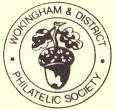8th December 2020 - Christmas Meeting - held via Zoom
With the Society unable to hold any physical meetings at this time, the meeting featured a brief display of material by many of the attendees, presented using Zoom video conferencing.
Alastair Nixon was first, with three interesting and scarce items. The first was the earliest recorded date of use of a Franking Meter in the UK. The second item was two examples of the "MOR" code (Mail Order Return) on Horizon labels that had been commercially used (rather than prepared to order). Alastair's final item was a selection of German Christmas stamps.
Richard Hawes showed a selection of Greek banknotes from the 1944 hyperinflation period. These ranged from a 5 Million Drachma from July to a 10 Billion Drachma in October.
He also showed the first Greek stamp that he ever collected, and entertained us with the story of how the war between Communists and Royalists led to the collapse of the Greek economy and to Richard's parents meeting.
Alwyn Lowe's topic was "The Centenary of African Troops in the French Army (1857-1957)". He showed a proof of the stamp and has now found examples of the stamps to go with it. He noted that there were over 200,000 African soldiers serving in the French army in the First and Second World Wars, and generally they were badly treated. The first president of Senegal was an ex-soldier who had also been a Prisoner of War.
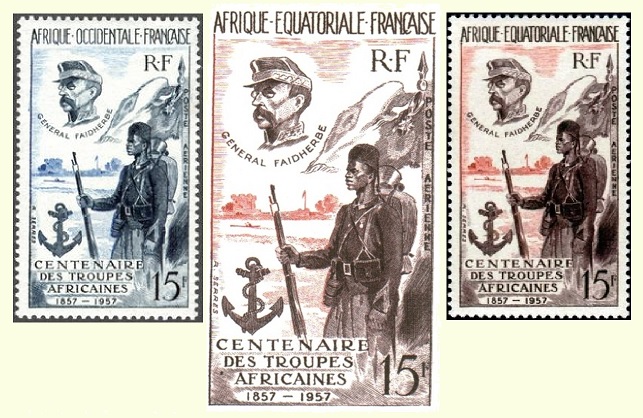
Christine Earle gave an attractive display of the New South Wales 1d and 1½d Christmas Postal Cards from the late 1890s. The surge in popularity of commercial Postcards encouraged the Post and Telegraph Department to join the bandwagon and they published the cards in 25 different designs with Christmas and New Year greeting overprints. She commented that they were not easy to produce, requiring three different printing methods. There were also many variants, as the colours of the message overprint and the vignette design were "mixed and matched". A further "Greetings From" overprint was later added, for non-seasonal sales.
Susan Greenwood has been working on her collection during the autumn and winter, and she showed a range of controls, some with inverted watermarks. This led to a discussion on Watermark Detectors, and whether or not it is safe to use Benzene to show watermarks on mint stamps - the consensus was that it is safe.
Roger Howard explained that in 1966 he had worked as a Radio Technician in Botswana. He gave a short history of the Territory, which as Bechuanaland had been divided into a Colony and a Protectorate. There had been no postal services until 1888, with mail being sent by runner.
Roger showed an impressive block of the ½d vermilion of Great Britain overprinted with both British Bechuanaland and Protectorate. The second overprint was applied locally and it is clear that there are many varieties in the alignment of the overprint. He assured us that the second printing was much better!.
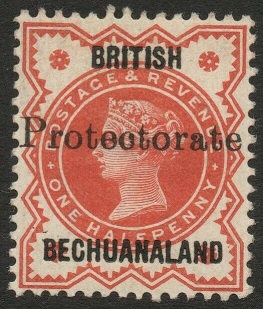
Our President Mark Bailey displayed several items of postal history from the 19th century, and he connected with Roger's material by showing a Registered cover from Bechuanaland to Jersey, followed by a normal cover from Vrijburg to Jersey.

The rest of Mark's display was of further items from his collection of the Campbell correspondence, including a ½d post card from Edward Denny Bacon (Past President of the RPSL) to Jersey with an 1889 London E.C. Hoster machine cancel, a Registered letter from Campbell to Argentina addressed to a philatelist that Campbell had known in Paris, and an 1888 letter from Jersey to Argentina. An unusual stationery item was a Registration Certificate from Argentina for an 1890 letter to Jersey. Mark also showed a post card sent from Melbourne, Australia to Jersey in 1889.

Mark finished his display with a card addressed to Campbell in Paris and an 1877 card from London to Campbell when he lived in Tours from a founder member and sometime Secretary of the Philatelic Society, London, Henri Alexis De Joannis.
Our Chairman Patrick Reid closed proceedings with a short display of 2020 acquisitions. These included a Tasmania Revenue 6d overprinted WAGES TAX that he had been hunting for over ten years, a souvenir postcard for the Launceston, Tasmania Exhibition of 1891-2, a stationery envelope produced for the Exhibition, which is believed to be the only recorded example and a scan of a coloured poster provided as a supplement to the (Tasmanian) Daily Telegraph showing the Exhibition Buildings (22 acres) with many commercial advertisements round the border.
Susan Greenwood sent us off in style with a rendition of "We wish you a Merry Christmas" on her violin.
24th November 2020 - Tasmania - A Broad Selection Part 2 - Patrick Reid
With the Society unable to hold any physical meetings at this time, Patrick's talk on the subject of Tasmania was presented using Zoom video conferencing.
Patrick presented Part 2 of Tasmania - A Broad Selection, which began with postal stationery, including illustrated envelopes, embossed envelopes, and newspaper wrappers. Patrick then showed postcards of the former penal colony at Port Arthur, and the nearby Eagle Hawk Neck, also picture postcards relating to early tourist trips to the area. The talk continued with private Letter Cards for Hobart and Launceston, and Patrick completed his presentation with Railway Newspaper Stamps and Parcel Stamps.
A video recording of Patrick's 30-minute talk can be viewed here.
10th November 2020 - Tasmania - A Broad Selection Part 1 - Patrick Reid
As the Society is unable to hold any physical meetings at this time, Patrick's talk on the subject of Tasmania was presented using Zoom video conferencing.
Patrick presented Part 1 of Tasmania - A Broad Selection, and showed material that covered pre-stamp postal history including cancellations, town letters, items sent for free, and instructional markings, early stamped mail, the Pictorial issue of stamps produced from 1899 until 1912, the Platypus stamps that were issued in 1880 and used for revenue and postage purposes, and £1 stamps overprinted for revenue use.
A video recording of Patrick's 30-minute talk can be viewed here.
28th July 2020 - Annual General Meeting
The Annual General Meeting was held on 28th July 2020, using Zoom video conferencing. In his report, the Chairman thanked the various members who run the Society.
He commented that 2019-2020 had been a very strange year for everyone in the Society. His report noted the diversity provided by the external speakers, with talks covering Dominica and Ireland, and from the Society's members, displays concerning The Midland Railway and New South Wales, as well as a diverse range of material at the meetings when the members have brought along selections of stamps, covers and cards from their collections. However, after a routine start to the year in January the Covid-19 Coronavirus pandemic came upon us with amazing speed in February and March, bringing devastation in its wake and severe restrictions on what we could do as we tried to contain its spread that have changed our lives completely.
The Honorary Treasurer's report and the accounts had been circulated to members ahead of the AGM. Likewise the reports had been presented from the Honorary Secretary, and the Packet Secretary. The Membership Secretary reported that the membership stood at 64 members.
The Committee recommended that the annual subscriptions would remain the same, and the decision was made at the AGM that subscriptions would be due from 1st November instead of 1st September, meaning that members had a 2-month subscription-free period this year.
As a result of the election of Officers and Committee, Mark Bailey stood down as Chairman, and was elected as the Society's President. Patrick Reid was elected as the Chairman. All the other Officers and Committee members were re-elected.
10th March 2020 - The Midland Railway - John Soer
John Soer, well-known to those who have been members for some time, has an important collection of Ashby-de-la-Zouch. However, on 10th March, he came to entertain and enlighten us on the subject of the Midland Railway.
John began by explaining that the original purpose of the railway was to distribute coal from Leicester. The line ran Derby - Nottingham - Leicester - Rugby, and connection to London St. Pancras was not achieved until 1868.
John showed us an 1840s timetable from the Bradshaw guide and a railway map of 1841, featuring three companies. The Midland Counties Railway ran from Derby to Nottingham to Leicester, The North Midland provided services up to Leeds and there were also services from Birmingham to Derby. All competed in the same market and eventually saw sense and in 1844 combined, rather than continue "cutting each other's throat", forming The Midland Railway.
The company accounts show that money was made from carrying coal. However, the railway also carried mail. There were Post Offices in the stations in Derby, Normanton (near Nottingham) and Gloucester. John displayed a range of postmarks from these offices.
The first Travelling Post Office was introduced in 1845, followed by the introduction of sorting carriages or sorting tenders on trains. We were shown postmarks from the London and Derby Sorting Carriage and the Lincoln and Tamworth Sorting Carriage.
John noted that "EMR" on a cover is not a TPO mark but signifies "Evening Midland Railway".

In 1891 a Railway Letter Service was introduced. To satisfy the Post Office, the extra charge levied was twice the regular postage rate. John showed us examples of this on cover. Originally overseas letters were banned, but this was allowed later. The rule had been ignored anyway!
To close the first half, John showed a 1909 letter from Sunningdale to Southampton, a series of oval handstamps used for the Railway Telegraph, Railway Parcel stamps (all green), Newspaper Parcel Labels, and finally postcards of Parcel Receiving offices in various locations.


The second part began with cancels from a range of Railway Sub-Offices (RSOs) where mail could be dropped off for onward transmission. Although RSOs were abolished in 1905, the datestamps continued in use.
Next came a range of Postal Stationery, including envelopes, wrappers at ½d rate and an item from Gloucester to Derby which had been "MISSENT TO LOUGHBOROUGH". These were followed by postcards and correspondence cards, including some used on the Company's ships travelling to and from Ireland.
John then displayed an impressive group of picture postcards showing views and locomotives and rolling stock specific to the Midland Railway. These cards were available from slot machines at Midland Railway stations. There are 80 different images and at least three printings. Four sets of cards were used as correspondence cards. These were later sold to the public, and a further twenty sets were later produced.
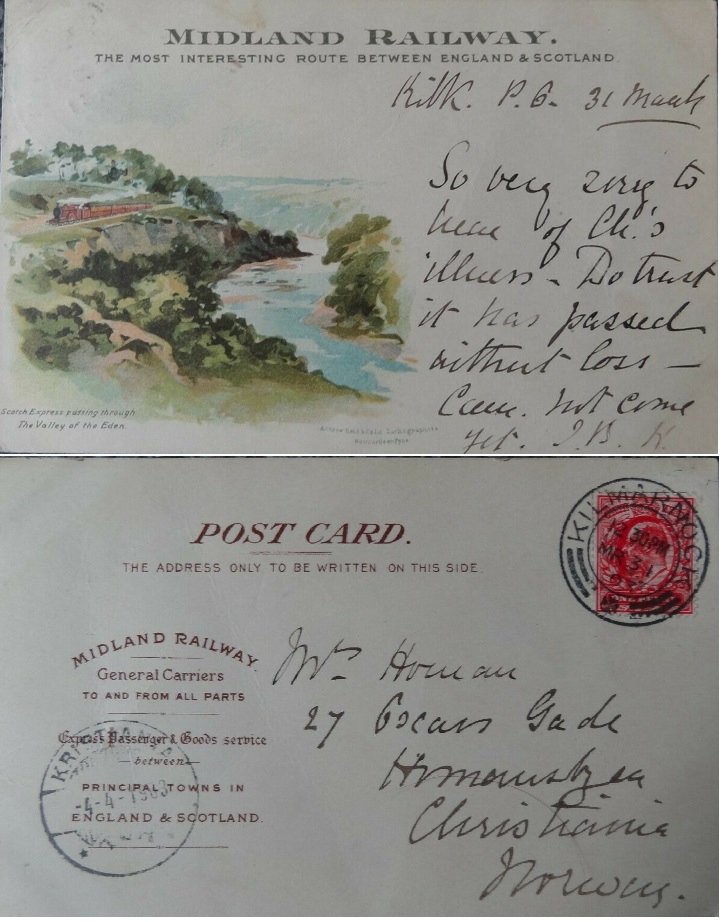
Next came a selection of postcards of Railway Posters. In 1908, the Morecambe to Heysham line (now closed) was electrified as the Midland Railway kept up with modern developments.
The company had "Flagship" Hotels in Manchester (Midland Hotel) and Liverpool (Adelphi Hotel). These were shown on postcards together with other Company hotels. We also saw Illustrated letterheads and hotel stationery.
To complete his display, John showed postcards of railway accidents followed by cards of stations, including Burton, Bournville and Long Eaton.
Mark Bailey gave the Vote of Thanks, complimenting John on the wide variety of material that he used to illustrate his subject.
25th February 2020 - On Becoming Independent
This was an evening of members' displays, on the subject of "On Becoming Independent".
Michael Curling opened proceedings, with a display of Hong Kong material covering the period from just before until just after the Colony was returned to China in 1997. He displayed issues showing the Queen's head on cover up to the hand-back, followed by the first issues as part of China, which were without the Queen's head.


Roger Sammons showed issues covering the transition from British Guiana to Guyana in 1966. The last colonial issue was overprinted "GUYANA/INDEPENDENCE/1966" initially by De La Rue and later locally.

This gave rise to a long and complicated set with varieties of both perforation and watermark, with further variety added by the local overprints in 1967. Roger followed this with the Independence issue and further local overprints. He ended with the ANGUILLA overprints (also from 1967) on the stamps of St Kitts, Nevis & Anguilla, which were only available locally and are very scarce.
Mark Bailey showed material from both Guernsey and Jersey marking the independence of their Post Offices, with accompanying newspaper cuttings that gave extensive details of what happened leading up to and on the first day of the Islands' postal independence. The early stamps were shown, both mint and on First Day Cover.

Alastair Nixon had brought along souvenir sheets issued by the USA to commemorate the Bicentenary of the Declaration of Independence. He also showed used examples of the 50 stamps issued, one for each state, in a further commemorative sheet.
Trevor Cornford displayed material from a range of former French Colonies in West Africa, including Mauritania, Dahomey, Chad, Cameroon, Ivory Coast, Mali and Senegal that included a number of mixed use frankings. He explained how the French had been brutal in the way that they granted Independence, often destroying infrastructure that they had built.
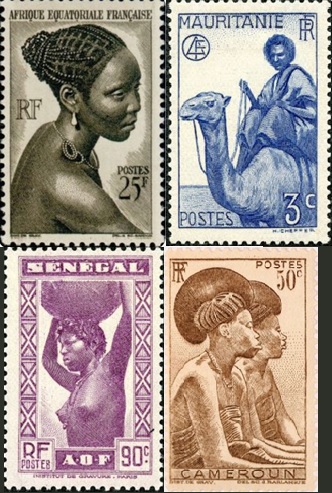
Trevor followed with material from the Belgian Congo, with a very brief account of what happened after Independence, and he ended his display with PoW Mails from the Boer War, relating these to an attempt to preserve Independence.
Mark Bailey thanked all who had brought material.
28th January 2020 - Material obtained in 2019
The topic for the meeting was items that the members had obtained during 2019.
Alastair Nixon opened the displays with GB slogan postmarks from the second half of 2019, including Congratulations England! ICC Cricket World Cup Champions and The Postcode is 60! 1959-2019.


Derek Steele displayed North American Airmails. The first cover he had brought along was supposedly an Amelia Earhart cover from 1932, but Derek was unsure that the flight between Halifax and St John's, Nova Scotia took place! He showed a number of items carried aboard flights by Major Frederick Sidney Cotton OBE (1894-1969), an Australian who developed technology for dealing with ice problems. He was also known for some key aerial photography during the war. These were the highlights amongst an interesting selection of flight covers.
Michael Curling showed a selection of local material, including an 1804 Wokingham letter, a taxed incoming postcard, nine Wellington College Station (aka Crowthorne) covers with various postmarks, Wellington local pubs on postcards, a Wokingham Registered Cover, and a Coronation cover. Michael completed his display with Coronation and Wilding First Day Covers.
Roger Sammons displayed year packs of Greenland issues for 2005/6/7/8/9 that he described as being the "Bargain of the Year".

Alwyn Lowe showed quite a selection of subjects, including Tombstone cancels and receiving house marks from London, Jubilee (Queen Victoria) cancels, 1d wrappers, Australian postcards, Field Service postcards, Newspaper wrappers from London to Los Angeles, British Empire Exhibition postcards for 1924 and 1925, advertising covers, First Day Covers from Jersey, an FDC for the wedding of Princess Elizabeth, the 1876 Centennial of the USA, and the Bicentenary of the Declaration of Independence.
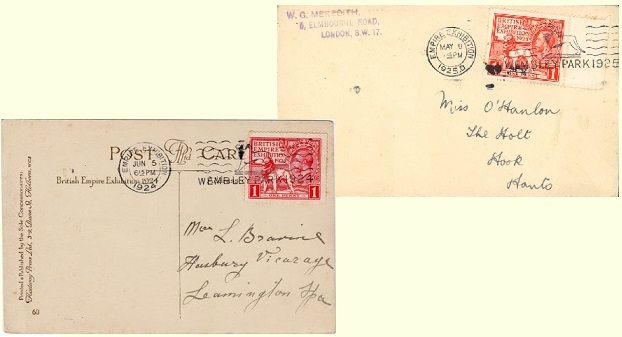
In the second half of the evening, Stephen Heath displayed US Presidents.
Trevor Cornford showed East African Airmails, a Francis Field glassine envelope, some Fiji First Flight Covers and a postcard of the Dornier DOX. These were followed by a Bermuda "Cotton Reel" commemorative, Sierra Leone self-adhesive stamps on cover, a Festival of Britain Souvenir Weather Forecast cover, Alderney locals used to Jersey, and a Guernsey Revenue on receipt. Trevor completed his display with a 1917 postcard to Russia, Taxed and Refused, a Ceylon PoW camp card, and three related picture postcards.
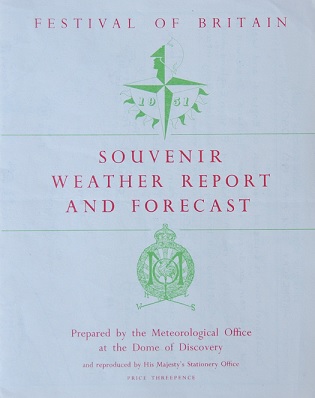
In his first showing, Mark Bailey displayed items of correspondence from George Patrick Campbell (1847-1903) in Jersey with the GPO about Registered mail, and a GPO Letter to the artist William Arthur Toplis (1857-1942) on Sark. These were followed by Belgian stamps issued for the 150th Anniversary of the Royal Philatelic Society London, including use on cover, and souvenir sheets from the celebrations at Stockholmia 2019, with one signed by Patrick Maselis (RPSL President). On the same topic he displayed Kyrgyzstan stamps including on FDC, and a Croatia Postal Stationery card, including one signed by the artist. These were followed by souvenirs of the Queen's visit to the Royal's new premises at 15 Abchurch Lane, London, a King Carl Gustav cover from Stockholmia, a Gibraltar souvenir cover, a USA cover from the 150th Anniversary event at the Smithsonian Institution, and a cover from 1969 for the Royal Visit to the Royal's old premises at 41 Devonshire Place.
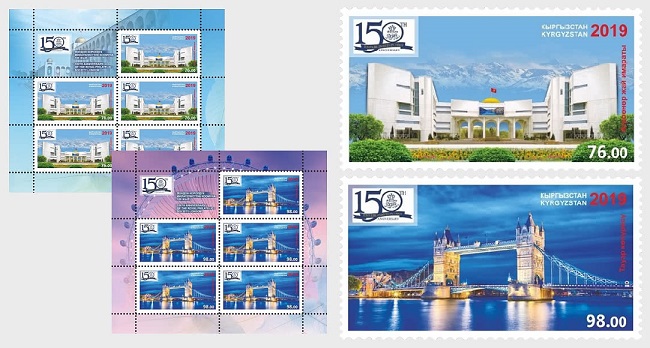
Chris Rayner displayed Isle of Man issues for 2019. The Island's issues included the spirit of Christmas, Sir Frank Gill, Town and Country Birds, Manx wildlife, 100 years of Transatlantic flight, Moby Dick, greetings in Manx, the Age of Rebellion, a new Royal baby, eminent Victorian engineers, maritime history, Apollo 11's 50th Anniversary, D-Day 75, Manx buses and the Chinese Year of the Pig.

Patrick Reid showed some items that he had added to his collection for his display to the Royal on 31st October 2019. These included colour trials for the Tasmania Pictorial Issue, De La Rue Proofs of the Tasmania Illustrated Letter Cards, some scarce "MORE TO PAY" covers for a section on Instructional Markings, and an oversize taxed cover from the section on Frank Stamps, which showed an attempt to use the Franking Privilege illegally.
In his second showing Mark Bailey displayed a range of souvenir envelopes from the stamp fair at Sindelfingen.
Finally, in his second showing, Trevor Cornford displayed five Falkland Island Dependencies covers, some Trade Cards for Shackleton and Scott and a large block of British Explorers stamps.
Mark Bailey thanked all who had brought material to show. As usual there was a wide range of items, with no duplication.
14th January 2020 - New South Wales - Graham Keates
The Chairman had decided that although billed as being the "Chairman's Evening", he would "sub-contract" the evening's display to Graham Keates, who had been unable to display in September 2019 owing to ill health.
Graham gave a brief overview of his philatelic history, and then explained the structure of his display. The first part would all be pre-1850, with stamps and covers in the second half.
He began with maps showing how the boundaries of New South Wales changed over time. Originally it included New Zealand, Tasmania and Norfolk Island as well as the settled parts of Australia. Over time, what we now know as Queensland and Victoria became separate colonies.
Graham explained that the purpose of transporting convicts to Australia was to rehabilitate the convicts and turn them into good citizens. In support of this he showed a "Ticket-of-Leave" which indicated that a convict had behaved well enough to be allowed to live on licence in the community until the end of their sentence.
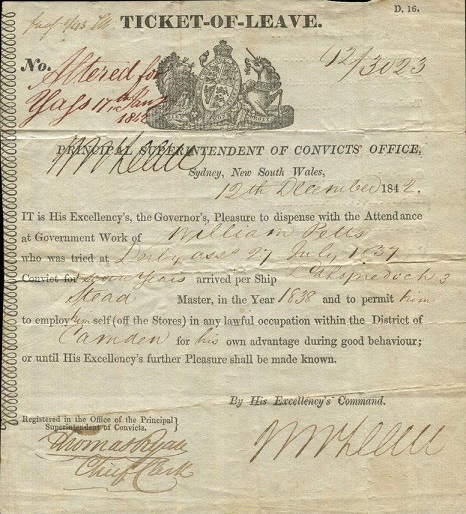
Next came some early letters, the earliest from 1829. Graham tries to collect entires that are complete with contents, as these give useful social information. Noted was a cover to Tasmania at a (special) 3d rate.
Postage rates were originally by weight and distance, but later by weight only, though the distinction between town, country, interstate and overseas remained.
Communication with the UK was slow, as ships took around six months to make the voyage, but this came down to around six weeks by the 1890s.
Graham showed the "World's First Postage Stamp", an 1838 pre-impressed paper for letters within Sydney. There was also a letter from Yass, on the edge of the desert. A range of Paid Ship Letters, most with good clear strikes, brought the first part to a close.
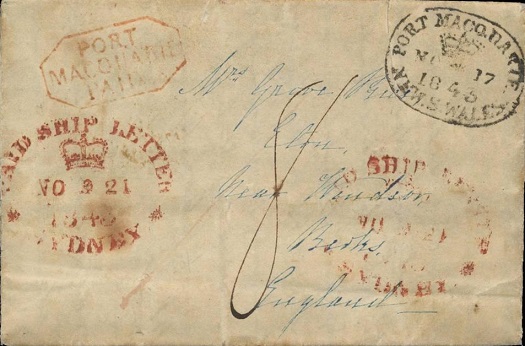
The second half began with examples of the "Sydney Views" stamps issued in January 1850. These are much sought after, and were unusual as there was no sovereign's head image included in the design. They were engraved locally on copper plates; the 1d by Robert Clayton (a convicted forger who had mended his ways), the 2d by John Black Carmichael (1803-1857) and the 3d by Henry Cooper Jervis. The stamps may be considered to be the world's first Commemorative stamps because of the date (1788, when the First Fleet arrived) on the bale in the design.

All three copper printing plates wore rapidly and were re-engraved by Henry Jervis in August 1850, with further re-engraving undertaken several times by Jervis.
In 1851, the second locally produced stamps, the "Laureated" issue bearing the Queen's Head, were engraved by John Carmichael and Henry Jervis on steel plates (1d, 2d plate 1, 3d) and on copper plates (2d plate 2, 6d, and 8d). The use of stamps to prepay postage was made obligatory in New South Wales in 1852. In 1860, the world's first bi-coloured stamp, a 6d for Registered Letters, was introduced.
These in turn were succeeded by the "Diadems". The plates were produced by Perkins Bacon in London and sent to Australia, with printing ink and paper. There are many variations on these stamps, with different papers and different perforations. Graham also showed forgeries of the "Diadems".
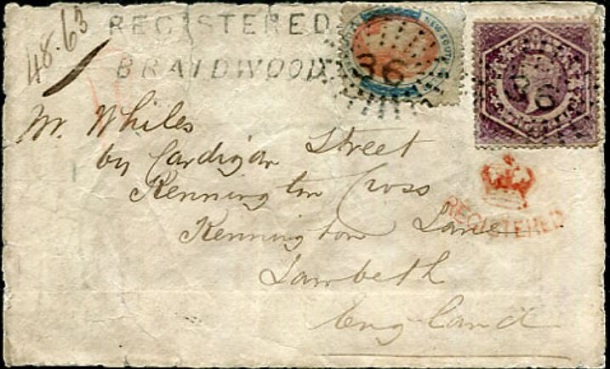
In 1888 a set of stamps was issued to commemorate the Centenary of the foundation of the Colony. Values up to 20/- were shown.
The 1897 Charity stamps, face value 1/- and 2/6, were displayed. These paid postage of 1d and 2½d respectively, with the balance being paid to a Consumptives (Tuberculosis) Home. These were followed by later issues of the Diadems.
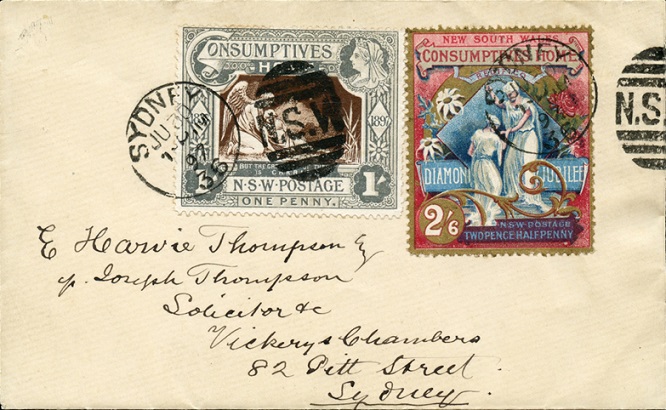
Graham ended his display with examples of the New South Wales Postage Due stamps and SPECIMEN sheets sent to the UPU. There was a final section on Postal Stationery, including Postal Cards and wrappers.
Patrick Reid gave the vote of thanks, complimenting Graham on a good display of what is a very complex collecting area.
